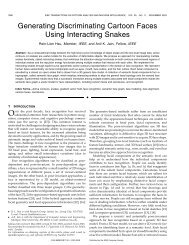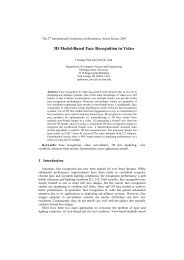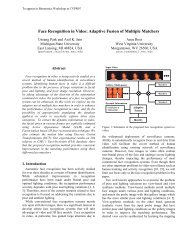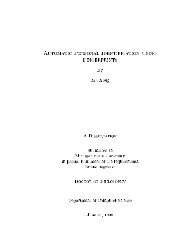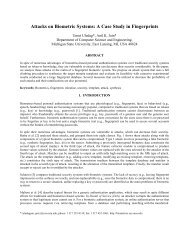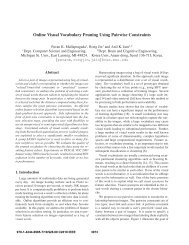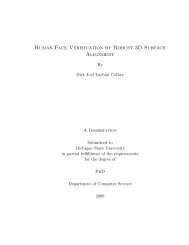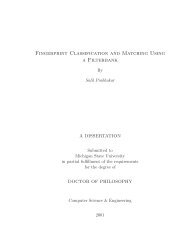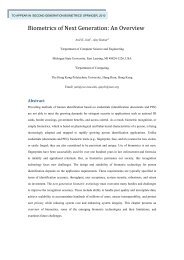Face Detection and Modeling for Recognition - Biometrics Research ...
Face Detection and Modeling for Recognition - Biometrics Research ...
Face Detection and Modeling for Recognition - Biometrics Research ...
You also want an ePaper? Increase the reach of your titles
YUMPU automatically turns print PDFs into web optimized ePapers that Google loves.
mouth is per<strong>for</strong>med within the face mask. The eye <strong>and</strong> mouth c<strong>and</strong>idates are located<br />
by using (i) a pyramid decomposition of the eye/mouth maps <strong>and</strong> (ii) an iterative<br />
thresholding <strong>and</strong> binary morphological closing on the enhanced eye <strong>and</strong> mouth maps.<br />
The number of pyramid levels, L, is computed from the size of the face c<strong>and</strong>idate, as<br />
defined in Eqs. (3.10) <strong>and</strong> (3.11).<br />
L = Max { ⌈log 2 (2σ)⌉, ⌊log 2 (Min(W, H)/F c )⌋ } ; (3.10)<br />
σ = ⌊ √ W · H / (2 · F e )⌋ , (3.11)<br />
where W <strong>and</strong> H represent the width <strong>and</strong> height of the face c<strong>and</strong>idate; F c × F c is the<br />
minimum expected size of a face c<strong>and</strong>idate; σ is a spread factor selected to prevent<br />
the algorithm from removing small eyes <strong>and</strong> mouths in the morphological operations;<br />
<strong>and</strong> F e is the maximal ratio of an average face size to the average eye size. In our<br />
implementation, F c is 7 pixels, <strong>and</strong> F e is 12 pixels.<br />
The coarse locations of eye <strong>and</strong> mouth c<strong>and</strong>idates obtained from the pyramid decomposition<br />
are refined by checking the existence of eyes/mouth blobs which are obtained<br />
after iteratively thresholding <strong>and</strong> (morphologically) closing the eye <strong>and</strong> mouth<br />
maps. The iterative thresholding starts with an initial threshold value, reduces the<br />
threshold step by step, <strong>and</strong> stops when either the threshold falls below a stopping<br />
value or when the number of feature c<strong>and</strong>idates reaches pre-determined upper bounds,<br />
N eye <strong>for</strong> the eyes <strong>and</strong> N mth <strong>for</strong> the mouth. The threshold values are automatically<br />
computed as follows.<br />
T h = α n<br />
∑<br />
(x,y)∈FG<br />
Map(x, y) + (1 − α) · Max Map(x, y), (3.12)<br />
(x,y)∈FG<br />
75



